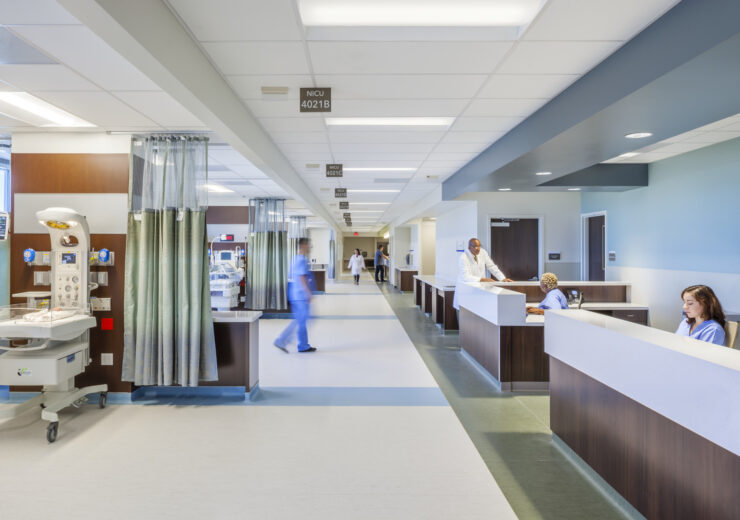Adam Mayer, senior manager at Qlik, discusses the need for data and analytics to be at the heart of the process when it comes to designing new hospitals

The emergence of endless new technologies in recent years have changed the way hospitals are designed from the outset (Credit: HMC Architects)
Data analytics is infiltrating every area of every industry imagineable right now – and the front line of the healthcare system is no exception. Adam Mayer, senior manager at US-based business analytics firm Qlik, discusses the growing need for data to be at the heart of the process when it comes to designing new hospitals.
On 25 February, Lord Wolfson, founder of the Wolfson Economics Prize initiative, announced that he will offer £250,000 for the best design of a new hospital that will improve patient care.
His rationale for the 2021 prize is that he believes the “design, facilities and technology” of hospitals “simply no longer provide the best clinical care”.
For entrants looking to participate in this competition, one key element of their proposal must be the use of data.
Data is now the lifeblood for all organisations. This is especially true in healthcare, where it underpins everything from optimising processes to informing analysis, and patient care pathways.
A shift towards a more digital ‘hospital of the future’ will only result in even greater volumes of data being created that must be used to constantly inform and improve processes and services.
This will be key to ensuring that the hospital of the future doesn’t become a static ideal that is outdated 20 years later, but takes advantage of the living, breathing nature of data to continuously learn and evolve, in turn driving better care and connected services.
But, of course, the health service isn’t making a standing-start when it comes to its use of data.
Many NHS trusts are already putting data at the heart of their operations to optimise service delivery and improve patient care. These learnings must inform the next generations of hospitals.

Learning from the best in the business
The potential for data and analytics to underpin the hospitals of the future is immense.
Indeed, Qlik’s research in partnership with IDC found 73% of healthcare organisations said operational efficiencies improved as a result of investments in data management and analytics.
Leading industry innovators are identifying new ways to put data at the heart of the decision-making process in hospitals.
The cutting-edge Analytical Command Centre at the University Hospitals of Morecambe Bay Trust (UHMBT) Royal Lancaster Infirmary site, for example, puts data at the heart of the emergency department with a number of interactive screens that present real-time analysis of capacity and demand, including the number of ambulances on the way to the hospital, and availability of beds.
This allows the team to continuously assess resources against demand, predict when surges may happen, and streamline the patient experience.
In turn, this has helped to reduce delays and has increased the percentage of patients triaged within 15 minutes from 65% to 95%.
Similarly, by empowering the patient flow manager at Wrightington, Wigan and Leigh (WWL) Teaching Hospitals NHS Foundation Trust to easily capture and analyse data on the number of patients awaiting discharge across different wards, the wait for MRIs at WWL has been reduced from 10 days to two – thanks to the identification of bottlenecks in the process.
The benefits these and other healthcare organisations have harnessed from increasing their use of analytics has proved critical in enabling them to make more informed decisions, faster.
Indeed, this has been illustrated during the pandemic, with Freedom of Information data sourced by Qlik revealing that 84% of NHS Trusts are using data analytics to manage their response.
At UHMBT, for example, new dashboards for the Analytical Command Centre were quickly spun up to track the infection status of patients coming into and in the hospital, helping provide greater transparency of the Covid-19 risk across the organisation to other patients and staff.
Future opportunities for data in hospitals
There is a significant opportunity to apply the learnings from these beacons of best practice for data in healthcare, as well as explore how data can solve new challenges in hospitals of the future.
Indeed, there are three key areas that I believe should be the primary focus.
The first is population health. There needs to be a greater focus on connecting the data of different health and care organisations to support the shift towards a population health model.
This model is critical to the sustainability of the health service in the long term, helping overcome the dependence on emergency departments for primary care by supporting earlier interventions in the community.
However, there are two significant roadblocks to achieving this. The first is around data integration; trusts will need to integrate data from different sources in near-real time and replicate it into different systems so that all organisations can access it in the moment.
Current integration processes that rely on batch uploads just aren’t cut out for this shared data model.
The second is that Qlik’s research has found that the majority of analytics solutions, 60%, currently deployed by NHS Trusts are not even capable of identifying population health patterns.
Organisations need analytical solutions that can combine real-time analysis with hyper-contextual data to help them achieve the Active Intelligence to inform population healthcare programmes.
The second key area of focus is cloud-based analytics. For healthcare to take advantage of digital and data technologies, they can’t expect their medical experts to sit behind a computer.
It needs to be easily consumable on any device, anywhere, and able to be easily shared between organisations in a governed way.
While many NHS Trusts currently offer this through the use of VPNs, cloud-based solutions provide a more seamless approach that omits the needs for laborious sign-in processes to access the information they need in the moment.
WWL is one trust that is currently rolling out cloud-base analytics, which will in turn support greater sharing of information with other healthcare organisations – including social care and mental health teams – to ensure a joined-up response in every situation, all within a governed framework so that data security is maintained.
The third and final key area is advanced analytics, and machine learning (ML). Predictive analytics and forecasting will be critical in helping hospitals manage resource and demand in the future.
For instance, being able to forecast a patient’s risk of readmittance helps manage unscheduled demand, as well as the resources that will likely be needed to deliver this additional care.
UHMBT is developing such a solution, which integrates autonomous machine learning capabilities into the analytics application stack, so the Analytical Command Centre can provide a daily prediction for readmittance.
Using data analytics to underpin better healthcare
Data must underpin every element of the future hospital – from new technological developments that leverage the IoT (Internet of Things) and powerful forecasting, to the decisions made by practitioners every day to deliver consistent, high-quality care.
The most successful hospitals will be those that invest throughout the intelligent analytics data pipeline to ensure that the relevant and real-time insights are received to inform decisions in the moment.
Achieving this Active Intelligence will empower individuals across the entire healthcare system to drive greater operational efficiencies and improve the patient experience of their services.
Giving data a pulse, and making it the heartbeat of the organisation, will ultimately create the foundation and be key to successful hospital designs in the future.
